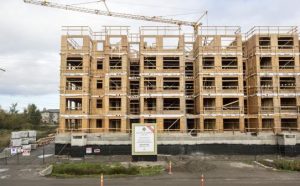

Alexandra Court in Richmond, B.C. BC Building Code requirements changed in 2009 to increase the maximum height for wood-frame residential construction from four to six storeys.
The Ministry of Municipal Affairs and Housing (MMAH), the Office of the Fire Marshal and Emergency Management (OFMEM) and the Ministry of Labour (MOL), have developed a new guideline that aims to enhance fire safety within and around mid-rise buildings while they are under construction.
The Best Practice Guideline complements recent amendments made to the Ontario Building Code, which permit mid-rise (five and six storey) buildings of wood frame construction. These amendments came into effect in January 2015.
Currently available in English and French on the MMAH, OFMEM and MOL websites, the Guideline includes best practices and considerations for builders and others involved in the construction and protection of these buildings, but does not constitute a Regulation.
Excerpt
- other than a designated smoking area.
Section 06 – B:
Heating Equipment, Including Fuel-Based Heaters
General requirements
- All heating equipment, both temporary and permanent, should: a) be installed, used, and maintained in accordance with the manufacturer’s instructions, and/or recognized safe practices; b) be situated so that it is secured; c) be operated by personnel familiar with the operation of the equipment; d) be maintained by properly trained personnel; e) not be operated if damaged or there is a potential safety hazard; f) and not have exposed radiant heating wires or open flames.
- The clearance between combustible materials and temporary heating equipment, including flues, should be in conformance with minimum clearances shown on certified heating equipment.
Fuel-based heaters
- Fuel-fired heating devices can pose a significant risk on a construction site unless appropriate precautions are undertaken.
- Fuel-fired heating devices should not have an open flame and should not be permitted except where they are located, protected and used in such a way that there is no risk of igniting a tarpaulin or similar temporary enclosure or combustible material near the heater.
- No fuel-fired heating device should be used in a confined, restricted or enclosed space unless there is an adequate supply of air for combustion and adequate general ventilation. This is also important to protect the health and safety of workers, and to limit temperature rise in the area.
- A fuel-fired heating device should be protected from damage and from overturning.
- No fuel-fired heating device should be located so as to restrict any means of egress.
- A fuel-fired heating device that generates noxious products of combustion should discharge the products of combustion outside the building or structure in which it is located.
- All fuel supply lines should be constructed, guarded or placed in such a way as to be protected from damage.
- Chimney or vent connectors, where required from direct-fired heaters, should be located at least 460 mm from combustibles or be protected with thermal barriers.
- Liquid- or gas-fired heaters should comply with regulations under the Technical Standards and Safety Act, 2000.
- Internal combustion engines and other devices capable of producing ignition should be kept at a safe distance from combustible material, but under no circumstances should be less than 1.2 meters unless other protection measures, such as thermal barriers, are provided.




